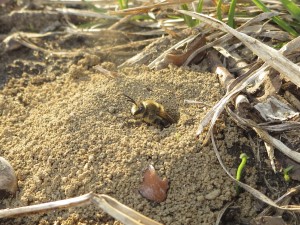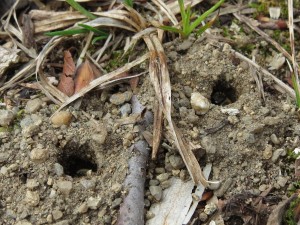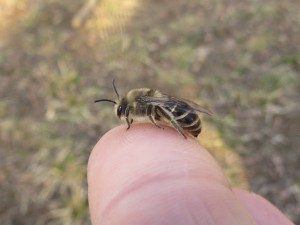
One of the first springtime insects that homeowners observe are ground bees. These insects create ant-hill like mounds in areas of bare soil with a ¼” opening in the center (about the thickness of a pencil). On warm, sunny days there may be dozens to hundreds of bees flying low to the ground among the mounds. Despite a general and perhaps debilitating fear of bees – the truth is that this species is relatively harmless and may not require any management. Here’s why:
- Ephemeral: ground-nesting bees are pollinators of early blooming flowers. Because their lifecycle is tied to the cycle of these plants, ground bees are only active for a short period of time in early spring.

Two female ground bees hunker down in their burrows in response to movement. - Solitary: fear of bees arises from the idea that disturbing a nest will provoke an entire colony of stinging insects. However, as it true of carpenter bees, cicada killer wasps, and mud dauber wasps, ground bees are solitary with only a single female bee per mound.
- Shy Gals: female bees make nests for the purpose of reproduction. After gathering nectar and pollen as food for their offspring, females will mate and lay eggs in the nest. While in the nest, females appear shy, and will retreat into the burrow if they see an approaching object.
- Males Hover, but Can’t Sting: All those bees you see flying low to the ground en masse – are males! And male bees do not possess a stinger. Their low, hovering flight is part of their effort to pair up with a female. Indeed, male ground bees are quite docile.

If you wish to discourage ground bees from living in your yard, an effective, safe and long-term solution is over-seeding with grass. By creating a dense lawn, bees will not be able to dig in the soil and will nest elsewhere.
For more information please see Ground nesting bees in your backyard!